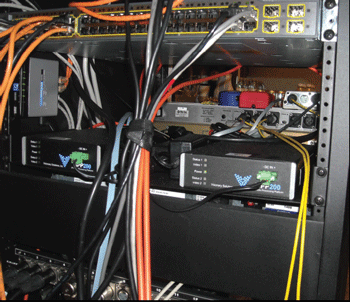Broadcasters’ Steady March Towards an All-IP Environment
OTTAWA—Video over IP has become the preferred way of shipping broadcast video for economic reasons. It is significantly less expensive to convert and compress video into files capable of being sent over semiprivate or even public Internet channels than it is to send raw uncompressed video over dedicated fiber or satellite channels. For instance, as a result of moving to video over IP, Showtime is saving “70 percent on bandwidth costs compared to what they paid before,” said T-VIPS COO Janne Morstol chief operating officer for T-VIPS, a Norwegian provider of signal processing technology.
Video over IP is also the most effective way for broadcasters to populate the diversity of screens in use today. These include HDTVs, PCs, tablets and the ever-growing number of smartphones running on Apple iOS, Android and BlackBerry operating systems.
Granted, video over IP has yet to get a solid footing within the internal production infrastructure of TV stations and networks, but as costs come down, this too is likely to change.
Visionary Solutions video over IP technology, at right, was used for live-to-air broadcast for the Republican National Convention in Tampa, Fla. PROGRESS AND POSSIBLITIES
Wes Simpson, president of Telecom Product Consulting in Orange Conn. and author of “Video Over IP” (Focal Press, 2008), is impressed by the technology’s progress in displacing dedicated telephone/ satellite circuits for moving broadcast video. “This trend is underway and fairly well established,” he said.


Simpson (who also writes TV Technology’s Video Networking column), is equally impressed that streaming media platforms are consolidating on a handful of major platforms such as Apple’s HTTP Live Streaming (HLS), Microsoft’s Silverlight, Adobe Flash and the emerging Dynamic Adaptive Streaming over HTTP (DASH). This move towards a few video over IP platforms, and away from a stable of proprietary formats, “is making it much easier to be a video content producer,” Simpson said. Such consolidation also makes this role less expensive, because there are fewer kinds of streams that need to be provided.
That’s not all. Thanks to enhancements to video compression techniques, broadcasters are delivering better quality pictures via video over IP to multiplatform devices, according to Thomas Lattie, vice president of product development for Harmonic. While improving quality, the bitrate reductions associated with these enhancements “are reducing transport and data costs.” On a per-viewer basis, this cuts the price for reaching eyeballs.
Looking ahead, the transport advantages offered by video over IP could provide broadcasters with some viewer-grabbing options. For instance, a broadcaster could take every single camera angle of a goal during a sports game, and offer them to viewers online in real time. The viewer could then select whichever camera angle suits them best, or go from one view to another as it suits them. This unprecedented level of choice is what’s possible when “video over IP transport takes away limits,” said Petter Ole Jakobsen, CTO of Vizrt.
The professional video industry's #1 source for news, trends and product and tech information. Sign up below.
Add the ability of video over IP to fit seamlessly into a broadcaster’s overall IP-based infrastructure—and to interact easily with the outside world—and one can see why it could make sense for a TV station/network to move to an all-IP workflow. Such an approach would give a broadcaster both “scalability and costeffectiveness,” said Gal Garnier vice president of Compression and Distribution Systems for Evertz. An all-IP plant would allow everything to work in this universe, starting at the camera and moving into production, editing, storage and multiplatform distribution.
THE OBSTACLES OF GOING ALL-IP
Clearly, there is a lot to be said for video over IP’s myriad possibilities. So what is holding this revolution back?
The main factor is cost. “When you look at the price of a broadcast baseband router and compare it to a Cisco IP router, the broadcast router is pretty compelling from a price standpoint,” said Simpson. Historically, price has always mattered to broadcasters, but now it matters more than ever due to the recession’s impact on ad revenues; competition from non-broadcast platforms for viewers, and the relentless growth of viewing options.
The second obstacle is legacy infrastructure. Broadcasters don’t want to tear out a broadcast-specific plant that still works. And when it is time to buy a new video router, broadcasters may be more comfortable with buying a new version of what they have now, rather than taking “the leap to an IP-based infrastructure,” said Eugene Keane CTO of Norwegian-based Nevion, which announced a recent merger with T-VIPS, in part to take advantage of the industry’s move to video over IP.
Do these obstacles mean that video over IP ascendancy may not be a sure thing? Not at all. It’s just something that will take time to occur. After all, the broadcast industry’s move to a file-based video workflow “took 15 years,” said Eric DuFossé, vice president of marketing for Grass Valley. “Moving forward, we can see baseband video going IP,” he noted, even if the process takes many years to come to pass.
James Careless is an award-winning journalist who has written for TV Technology since the 1990s. He has covered HDTV from the days of the six competing HDTV formats that led to the 1993 Grand Alliance, and onwards through ATSC 3.0 and OTT. He also writes for Radio World, along with other publications in aerospace, defense, public safety, streaming media, plus the amusement park industry for something different.

